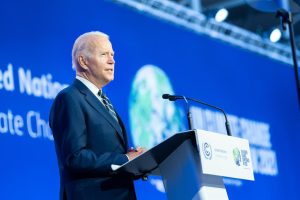Government action is the most effective way to reduce climate change
December 17, 2021
The annual United Nations Climate Change Conference (COP26) serves as a reminder of the growing problems stemming from climate change. While many nations have collectively agreed on the steps needed to reduce climate change, little progress has been made. Climate change cannot be single handedly improved by individual action, it needs to be improved through international government action.
Thankfully, the purpose of COP26 is to allow nations to negotiate with each other to find strategies to reduce climate change, with the goal of preventing the world from heating more than 1.5 degrees by the end of the century. Anything more than 1.5 degrees will lead to catastrophic events, such stronger storms and fires, along with droughts and the melting of the polar ice caps. In order to prevent this, nations must cut their carbon emission levels in half by 2030.
Out of all five main carbon emitting sources — energy, industry, transportation, buildings and agriculture — government action can reduce all of them, unlike community-based action. Individual action is still very important for reducing carbon emissions;however, government action is the most effective way to get to the 1.5 degrees goal.
The top leading carbon emission sources globally are from energy. According to the United Nations, 80 percent of the world’s energy comes from the use of fossil fuels. Fossil fuels are responsible for two thirds of the global carbon emissions. Unless individuals can afford solar energy, there is not much people can do except rely on fossil fuels for energy. Governments, on the other hand, have full responsibility for the usage of fossil fuels and need to stop relying on them.
Shifting to cleaner and renewable energy sources, such as wind, hydro and solar power will not only reduce carbon emissions, but will boost electrical power and reduce air pollution. Renewable energy also creates cleaner and safer jobs that can improve and boost economies. This would be beneficial for countries like China who have problems with air, water and land pollution due to the greenhouse gases produced.
As for transportation, buildings and agriculture, governments can increase regulations that will improve the sustainability and efficiency of these carbon-emitting sources. This will reduce the emissions created by them.
As of 2018, the top carbon-emitting countries are China, the United States and India. These counties combined are responsible for 42.8 precent of the global carbon emissions. At COP26, India announced an updated carbon plan that will significantly reduce carbon emissions by 2070. China also updated its climate change plan;however, for a country with the leading amount of carbon emissions, not enough progress is being made.
President Joseph Biden has also taken steps to reduce carbon emissions in the United States. Biden has rejoined the Paris Climate Agreement and now has created the Build Back Better Framework. This policy, along with his Infrastructure deal, aims to cut greenhouse gas pollution by 50 percent by 2030, lower the cost for clean energy, improve water and air quality and finally create clean, well-paying jobs.
However, these steps aren’t enough. Even with the updated plans, Earth is still predicted to heat to 2.7 degrees, which is much higher than the 1.5 degree goal. Governments are responsible for the well-being of their citizens. If climate change continues at this pace, the increasingly catastrophic weather will undoubtedly harm humanity. For this reason, governments need to cooperate with each other and step in more to improve climate change.







